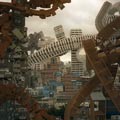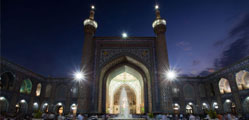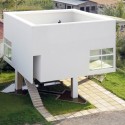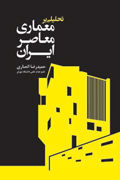هرچند هنوز هم فکر می کنم طرح ایوانهای سبز اون ساختمون کاری فوق العاده ست

Courtesy of Wikimedia Commons, © Daniel Schwen
As part of an international competition to design Boston's City Hall in 1962, three Columbia University professors, Kallmann, McKinnell & Knowles, diverted from the typical sleek, glass and steel structures that were being requested by popular demand. Rather than basing their design on the material aesthetics, their goal was to accentuate the governmental buildings connection to the public realm.
Completed in 1968, the Brutalist style city hall bridges the public and private sectors of government through a gradient of reveal and exposure that allows the public to become integrated, either physically or visually, into the daily affairs of the governmental process.
More on the Boston City Hall after the break.
Courtesy of Wikimedia Commons, © Lebovich
Unlike many of the other entries for the competition that implemented glass and steel in their modernist designs, Kallmann, McKinnell, and Knowles used rough beton-brut concrete to contrast from the modernist designs that were proliferating throughout the United States and Europe at the time. They strove for an architecture that was involved with its social, cultural, and political context where the one can understand the methods behind the design, both programmatically as well as construction methods. The result is a concrete, tripartite design that stratifies the public from the administrative.
The city hall is divided into three main entities that make up overall system. Its division, both volumetrically and programmatically, is essentially a division of public and privatized spaces that are emphasized such that as the building tapers into a cantilevering system, the more private aspects of the city government are directly related.
Courtesy of Wikimedia Commons, © Lebovich
From the street, there is a large open plaza that separates one from the main entrance to the city hall. For Kallman, McKinnell, and Knowles, the plaza was supposed to be an extension of the main floor of the building, which becomes suggested as the plazas brick pavement begins to transition into the lobby's quarry tile. In effect this subtle transition becomes a means by which the city hall is able to establish a relationship between the public sector and the everyday affairs of the government.
As the building continues to taper out, the building becomes more of standardized, bureaucratic façade system, which directly relates to the work happening within. At the uppermost floors where the mayor's office workers are located, the façade system is structured on a monolithic scale appearing as an ancient triglyph the wraps the perimeter of the building.
Courtesy of Wikimedia Commons, © Lebovich
At the heart of the building is where the strict façade system becomes broken and articulated so that moments in the building are revealed to those in the plaza. These protrusions and breaks in the façade are meant to be the ways in which the public can visually become part of the day to day activities within the mayor's office. It's this juxtaposition and new spatial protrusions that are constantly recreating the relationships between the government and the people where either physically or visually the two are always connected.
Since the Boston City Hall has been completed, it has had a mixed review from the citizens of Boston, architects, and even the mayors of Boston. In 2006, the mayor of Boston had actually filed a petition to have the building destroyed in order to make way for a better, more efficient building that was "aesthetically pleasing." However, since that has happened, a group of activists have been able to have the city hall given a special landmark status that prohibits any future modifications until it can be granted full landmark status.
Courtesy of Wikimedia Commons, © Lebovich
"We distrust and have reacted against an architecture that is absolute, uninvolved and abstract. We have moved towards an architecture that is specific and concrete, involving itself with the social and geographic context, the program, and methods of construction, in order to produce a building that exists strongly and irrevocably, rather than an uncommitted abstract structure that could be any place and, therefore, like modern man— without identity or presence." – Kallmann
Architects: Kallmann, McKinnell, & Knowles
Location: Boston, Massachusetts
Project Year: 1963-1968
Photographs: Wikimedia Commons
References: GreatBuildings, Wikipedia
- ۹۰/۰۶/۱۱





















